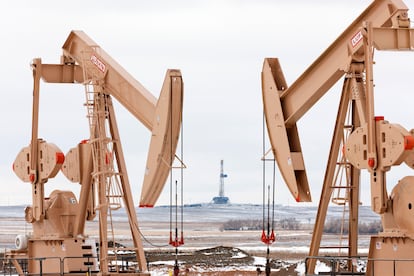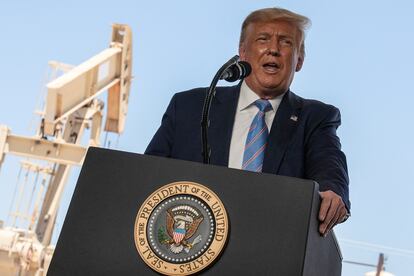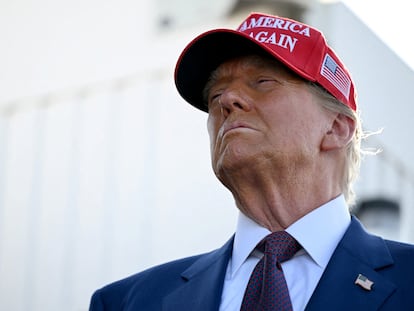Trump’s ‘drill, baby, drill’ meets reality: The US cannot extract much more oil if the price keeps falling
Experts warn that the energy sector is not contemplating a boost in production, despite the president’s messages. The country is already the world’s leading oil producer, but fracking deposits lose profitability when the price per barrel falls below $70

Since his return to the White House, Donald Trump has started off his second term with high energy levels. The mantra “drill, baby, drill” was one of his campaign slogans, and he put it into practice as soon as he was sworn in.
On his first day in office, he declared an energy emergency in the country, aimed at rolling out the red carpet for the industry to produce more oil. At his inauguration, he promised to ”bring prices down, fill our strategic reserves up again right to the top and export American energy all over the world.” But, like so many other measures solemnly announced by the Republican businessman, this boost to oil production is running up against a reality that isn’t so favorable to his plans.
The greater the production, the greater the pressure on the price of oil to continue to fall. And this is amid a context with numerous elements that are already pushing for its decline. With cheaper oil, U.S. energy firms have less incentive to produce, in a market in which new crude oil extraction requires high prices to be truly profitable. Furthermore, the tariffs Trump has announced on Canada — which are limited to 10% for oil — work against the cheapening of crude oil that Trump intends. The U.S. buys more than half of its crude oil imports from its northern neighbor. Hence, the taxes imposed on these imports will have a direct upward effect on the gasoline consumed in the American Midwest.
Beyond crude oil imports, the United States has become the world’s undisputed leading oil power. It reached this dominance following the outbreak of the war in Ukraine. The serious energy crisis unleashed by the Russian invasion precipitated the U.S. to boost its natural resources. Today, the country has a market share of 16.1% of global oil production, ahead of Russia and Saudi Arabia.
U.S. crude oil extraction activity already registered a strong boost under the Biden administration. Firms also took advantage of an environment of higher prices than at present. Experts doubt that production will rise much further, even despite Trump’s stimuli. “In the U.S., it’s the price level that determines oil production, and the expected prices don’t allow for greater production. The country is already dominant in energy production. And there’s already a surplus in the oil market; it doesn’t need more. The investment effort is [currently not] in oil. [Rather], it’s in artificial intelligence,” explains Francisco Blanch, head of global commodities at Bank of America.
Bank of America forecasts that the U.S. will slightly increase its oil production this year, from the current 13.5 million barrels per day to 13.7 million by the end of the year. This increase will still consolidate the U.S. as an oil power, although it doesn’t represent an increase in production comparable to that of years ago. Thus, the declaration of an “energy emergency” simply implies the granting of permits and the cancellation of prohibitions and limitations on exploration, both in federal territories on land and offshore. For instance, hydrocarbon extraction will be authorized again in areas that were previously protected in Alaska.
Back in his first term (2017-2021), Trump greenlighted offshore drilling, a measure that was followed in a completely residual manner by the industry. This is according to Beatriz Villafranca, an economist at CaixaBank Research. “The context for producing more oil in the U.S. is favorable, but oil companies are more reluctant than in the past to invest. In recent years, they haven’t devoted resources to more efficient drilling processes, but rather to rewarding shareholders with buyback programs and dividends,” she explains.
In this sense, the level of crude oil prices is even more decisive for the profitability of the U.S. industry, which has turned to the technique of fracking, or hydraulic fracturing. This process is much more expensive, meaning that a further drop in prices could impact it. According to BBVA Research, for these shale wells, the extraction cost — or the selling point at which the firm can break even — sits at around $54 per barrel. “However, this market in particular has been managing higher expectations of minimum profitability and return,” affirm Marco Antonio Lara and Alejandro Reyes, economists at BBVA. “Several projects begin to reduce their activity when prices fall below $70 per barrel.”
From Bank of America, Blanch adds that $65 per barrel West Texas is the level from which oil extraction in the U.S. would begin to lose profitability. Currently, West Texas crude is trading at $72.9 and Brent Crude is trading at $75.7 per barrel.

For Pilar Aranda — an analyst at Bankinter, a Spanish financial services company — a good indicator of the low expectations of the oil industry to produce more is the recent stock price of the large oil infrastructure companies in the U.S., such as Schlumberger, Halliburton, or Baker Hughes. Their shares have actually fallen since Trump took office. Specifically, Halliburton shares have fallen by 4.9% this year, a decline that’s mainly explained by the disappointment caused by the results of the fourth-quarter of 2024. Revenues were lower than expected, and the company announced that it expects a moderation of activity in the United States.
“Companies expect a certain rebound in drilling activity in the next six months, but don’t yet expect significant increases in production. The prices required for a substantial increase in drilling remain higher than their long-term price expectations,” concludes the Federal Reserve of Kansas in a recent report.
Sign up for our weekly newsletter to get more English-language news coverage from EL PAÍS USA Edition
Tu suscripción se está usando en otro dispositivo
¿Quieres añadir otro usuario a tu suscripción?
Si continúas leyendo en este dispositivo, no se podrá leer en el otro.
FlechaTu suscripción se está usando en otro dispositivo y solo puedes acceder a EL PAÍS desde un dispositivo a la vez.
Si quieres compartir tu cuenta, cambia tu suscripción a la modalidad Premium, así podrás añadir otro usuario. Cada uno accederá con su propia cuenta de email, lo que os permitirá personalizar vuestra experiencia en EL PAÍS.
¿Tienes una suscripción de empresa? Accede aquí para contratar más cuentas.
En el caso de no saber quién está usando tu cuenta, te recomendamos cambiar tu contraseña aquí.
Si decides continuar compartiendo tu cuenta, este mensaje se mostrará en tu dispositivo y en el de la otra persona que está usando tu cuenta de forma indefinida, afectando a tu experiencia de lectura. Puedes consultar aquí los términos y condiciones de la suscripción digital.
More information
Archived In
Últimas noticias
Chris Martin, Taylor Swift, Elijah Wood and other famous wedding ‘crashers’
‘How does it feel to be a failure?’: Elizabeth Berkley’s journey from ‘Showgirls’ ridicule to vindication
The story of the Málaga virus: The code that haunted Google’s cybersecurity center director for 30 years
The impact of Ecuador’s mega-prison: A polluted river, cleared forests and military checkpoints
Most viewed
- Christian Louboutin: ‘Young people don’t want to be like their parents. And if their parents wear sneakers, they’re going to look for something else’
- The low-cost creative revolution: How technology is making art accessible to everyone
- Liset Menéndez de la Prida, neuroscientist: ‘It’s not normal to constantly seek pleasure; it’s important to be bored, to be calm’
- All the effects of gentrification in one corner of Mexico’s Colonia Roma
- December Social Security and SSI payments: Dates, double checks and the 2026 COLA increase











































